German stocks are struggling to continue driving the existing rally higher in the midst of the latest global developments. As a result of that, the DAX index is still unable to break out above the psychologically significant resistance at 14000.000, after several failed attempts.
The future of the bullish market is jeopardised by shifting investors' sentiment. U.S. Treasury yields recently picked up from their historically low levels, which is raising investors' demand for bonds. This is owing to the fact that higher Treasury yields are making the stock market less appealing to investors. This trend is starting in the U.S. but is extremely likely to spill over to Europe and the rest of the world. Hence, the DAX may be due for another major correction.
Meanwhile, global economic trends also appear to be disadvantaging German stocks. Despite Germany's recently observed recuperation in manufacturing, the services industry continues to be weighed down by the pandemic. This means that the country's broader industry continues to be on track to uneven recovery, resulting in more uncertainty for the German stock market. This trend is further bolstered by the even stronger stabilisation of U.S. manufacturing.
Overall, the underlying fundamentals seem to favour a likely dropdown of the DAX in what might transform into a more sizable correction. Nevertheless, the situation is not yet at a tipping point where such a dropdown would seem imminent. That is why a more thorough examination of the current technical outlook is needed in order to discern when such a correction is likely to emerge.
1. Long-Term Outlook:
As can be seen on the daily chart below, the price action of the DAX is currently in the process of developing a Rising Wedge pattern. The more that the price action consolidates in an increasingly narrower range - the bottleneck of the pattern - the likelier it gets for a sizable breakout to develop in either direction. Notice that the bottleneck is developing around the 14000.00 psychological resistance, which is making the eventual breakout play even more significant. That is so because such psychologically fused barriers seldom turn into decisive make-it-or-break-it points for an existing trend.
In other words, unless the price action manages to break out above the Wedge's upper boundary on the third attempt, a subsequent bearish reversal, which is inlined with the aforementioned fundamentals, would seem like the most plausible outcome. Notice that the upper boundary of the Wedge has already been tested on two occasions, whereas its lower border has been reached on three separate instances. This implies that the price action is likely to test the two of them once more before the Wedge gets completed.
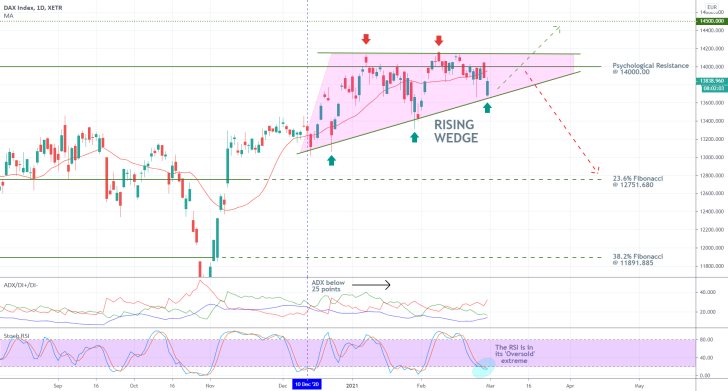
The ADX indicator has been threading below the 25-point benchmark since the 10th of December, which means that the market is currently ranging. This ostensibly range-trading environment, which became prevalent just as the Wedge started emerging, is suitable for the emergence of a bearish correction.
Notice, however, that under these ranging conditions, the Stochastic RSI indicator currently finds itself in its 'Oversold' extreme. This could prompt the resurgence of buying pressure in the short-term, likely driving the price action towards the upper limit of the Wedge. That is why bears should not rush to sell right away. Instead, they can look for an opportunity to short the DAX provided that the price action establishes an additional fakeout above 14000.000.
2. Short-Term Outlook:
The 4H chart below examines the consolidation of the price action towards the bottleneck in greater detail. It is worth mentioning that while the price action has already established two swing highs on the same level, the corresponding swing lows have been rising. At the same time, the MACD indicator has been underpinning the development of a Divergence as the underlying bearish momentum has been steadily rising. All of this signifies the waning bullish bias in the market, which is very likely to be followed by a bearish correction.
Meanwhile, the price action remains concentrated below the 100-day MA (in blue) and the 50-day MA (in green). The fact that recently, the latter crossed below the former is also demonstrative of rising bearish pressure - another piece of evidence justifying the expectations for a bearish correction. Hence, market bears should indeed look for an opportunity to sell the DAX provided that the bullish test of the bottleneck fails.
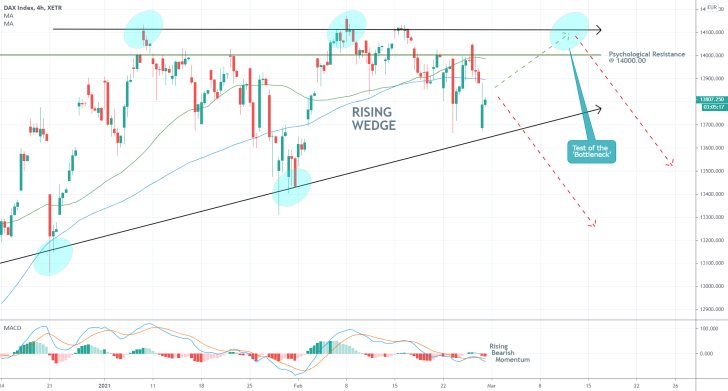
The underlying momentum is indeed becoming increasingly more bearish in the short-term, as illustrated by the MACD indicator on the hourly chart below. Less risk-averse traders can continue monitoring the descending channel's future development (as seen below) and use it as a potential entry indication.
Namely, if the price action establishes another minor swing low that is positioned below its predecessor (below 14000.000), they can use this opportunity to implement trend continuation strategies by going short at the resulting peak. However, this approach would be considered riskier than the one alluded to above because traders will be selling the DAX before the price action attempts another test of the Wedge's upper border.
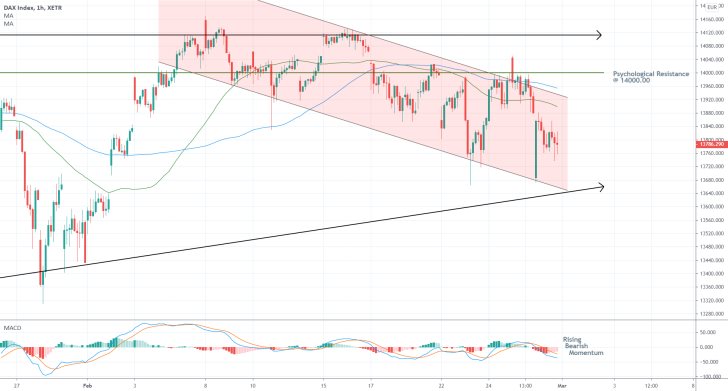
3. Concluding Remarks:
Market bulls do not seem to have many trading opportunities at the present moment, given the shifting investors' sentiment. Seemingly, the best they can hope for is to go long on the first throwback to 14000.00 from above, after a decisive breakout above the Wedge's upper boundary.
In contrast, bears do seem to have more trading opportunities in the short-term. They can wait for the price action to establish another bullish pullback - either to the Wedge's upper border or the 14000.000 resistance - before they go short at the resulting peak. The first longer-term goal for any sizable correction would be the 23.6 per cent Fibonacci retracement level at 12751.680.
German Stocks Likely to Dive as Bearish Pressure Ramps Up
The stock market is currently going through a tumultuous time as investors weigh in on the possibility of rate hikes in the near future. In a highly anticipated speech from yesterday, FED Chair Jerome Powell commented on the latest economic developments globally and investors' concerns regarding likely policy tightening sooner rather than later.
FED's number one also reflected on the growing inflation in the U.S. and the rising yields. While prices continue to rise, headline inflation remains below FED's long-term goals. Moreover, the FOMC had previously expressed readiness to show more leeway when measuring inflation, as it expects to see inflation fluctuate above and below the 2.0 per cent symmetric target in the mid-term.
While Powell hinted that FED's accommodative monetary policy is likely to remain at least until the end of 2022, investors' worries do not seem to be entirely removed. U.S. stocks retreated yesterday, which is also reflected in the European stock market.
As regards the German DAX, the index is suffering not only from these factors but also from the bumpy and uneven recovery that continues to pose uncertainty for the European industry. Overall, the underlying fundamentals seem to be favouring the continuation of the bearish sentiment on the index, but how low can the DAX go?
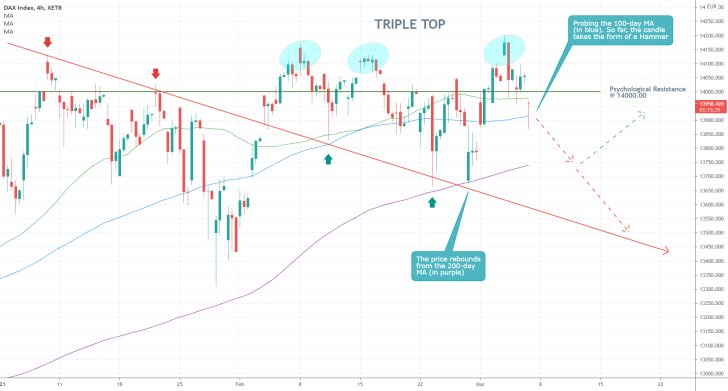
As can be seen on the 4H chart above, the price action recently broke down below the psychological resistance (previously support) at 14000.00, which was forecasted by the initial analysis. This happened following the establishment of yet another fakeout above the resistance, resulting in the creation of a Triple Top pattern.
Triple tops typically entail mounting selling pressure and likely bearish reversals stemming from an existing uptrend. This represents the biggest piece of evidence signalling the possible continuation of the bearish correction further down south. The price action could fall as low as the 200-day MA (in purple), or even the descending trend line (in red) before the bulls regain control.
However, bears should keep in mind that the last time the price action touched the 200-day MA, this was followed by a snap bullish rebound. Moreover, the current candle is currently taking the form of a Hammer, which indicates strong bullish pressure in the short-term. Hence, even though there are strong indications to expect continued price depreciation in the foreseeable future, this is not at all certain.
Seeing as how the price action is currently consolidating between the 100-day MA (in blue) and the 50-day MA (in green) and the psychological resistance at 14000.00, the DAX could be finding itself at another make-it-or-break-it bottleneck. In other words, a decisive breakout of the price action away from this range (in either direction) would likely confirm the next direction for the index.
The DAX is Free to Continue Rising
The underlying sentiment on the global stock market has changed for the better recently. The robust recovery in the U.S. and elsewhere has helped stocks to continue advancing on reinvigorated hopes for better economic prospects in the second quarter, while Joe Biden's fiscal stimulus plans have mitigated, at least for the time being, investors' fears concerning rising bonds yields.
Meanwhile, central banks in Europe and in the U.S. are expected to maintain their accommodative policy stances at least until the end of 2022, which will further bolster European stocks' rally. When all of these factors are examined in conjunction with each other, the probability of the German DAX index continuing to advance into uncharted territory seems very high indeed.
The only potential impediment that can conceivably stave off DAX's rally is the uneven vaccination progress in Europe that continues to be bungled by various developments. Chiefly, the AstraZeneca woes concerning production troubles at the industrial level and recently emerged safety fears have stymied the vaccine rollout. These fears are manifested by concerns that the AstraZeneca jab could be causing blood clots in the system, thus increasing the risks of death amongst older recipients.
At the time of writing, these concerns are scientifically unfounded, given that not a single medical agency in Europe has found any evidence to justify them. Therefore, the German government's decision, as well as other EU governments, to temporarily suspend vaccinations with the AZ jab jeopardises the tentative recovery in the Eurozone. That is why the developing situation could potentially end up having a negative impact on the DAX index.
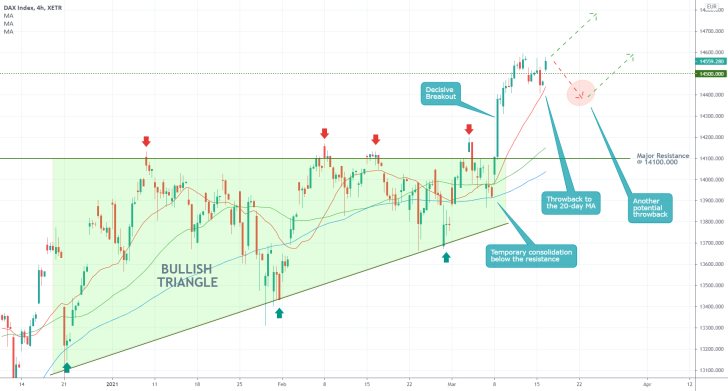
As regards the current technical outlook, the DAX seems poised to continue appreciating in the near future, following the successful completion of a bullish breakout from the Triangle pattern. This is shown on the 4H chart above.
For the time being, the price action appears to be momentarily consolidating between the major resistance level at 14500.000 and the 20-day MA (in red), which serves the role of a floating support. This presents market bulls with the opportunity to join the existing trend before the upswing is resumed. The prevailing bullish sentiment is underpinned by the perfect ascending order of the three moving averages - the price action being concentrated above the 20-day MA, which is positioned above the 50-day MA (in green) and the 100-day MA (in blue).
Given the size of the latest upswing (approximately 600 basis points) emerging from the Triangle, the price action could be projected to appreciate an additional 500-600 BPs before the bullish bias is checked. However, bulls need to keep in mind that the current consolidation may not yet be exhausted and that an additional dropdown towards the red sphere is possible. That is why they should place their SLs accordingly.
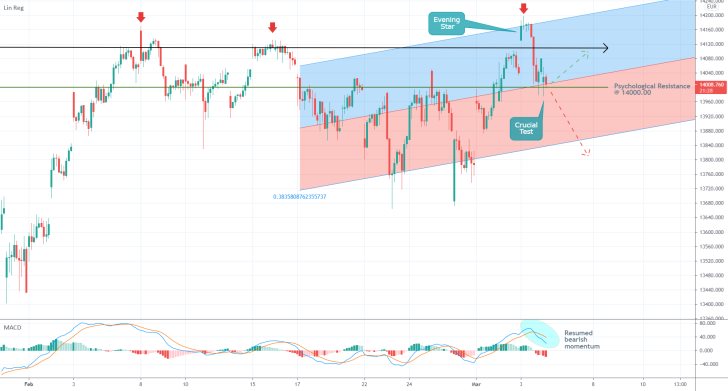
- As expected, the DAX shot up to the upper boundary of the Wedge (as shown in the initial analysis). After establishing an Evening Star pattern, the price action retraced back to the psychological resistance (currently support) at 14000.000. Notice that in addition to consolidating (over the last four hours) above this support, the price action is also consolidating above the middle line of the regression channel.
- The price action will have to break down below both of these decisively before bears can expect a more sizable correction. In contrast, bulls will be looking for potential signs of stabilisation around 14000.000, as they will be hoping that the bearish pullback bottoms out near the current market price.
- In other words, bears will be looking to sell once the price breaks down below 14000.000, whereas bulls will be hoping to buy at the next dip.
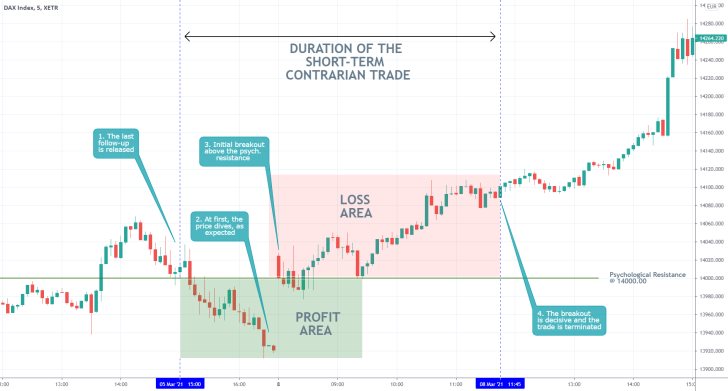
- Initially, the price action indeed started to depreciate, as per the projections of the last follow-up analysis. However, this was promptly followed by a snap rebound above the psychological resistance level at 14000.000. Once the decisiveness of the breakout became apparent, the position was terminated with a loss.
- It was a good thing that the follow-up cautioned against such a possibility, which prevented further losses. The follow-up succeeded in one key regard-it projected quite accurately that a massive upswing was due shortly after the breakdown/breakout was observed.
- Traders should keep in mind that whenever there are big concerns in the stock market regarding investors' sentiment in the mid-term, the underlying trading environment tends to become volatile and hard to project.
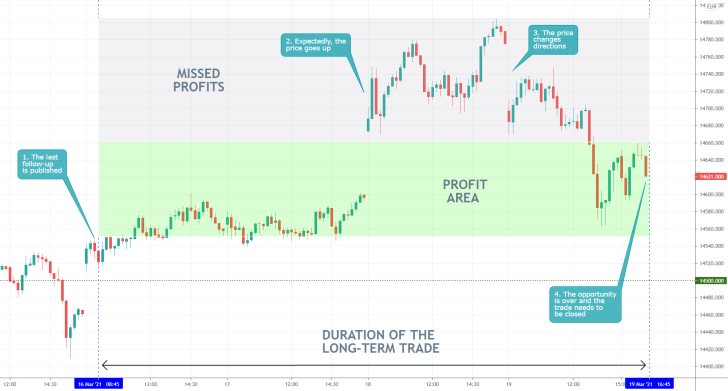
- The expectations of the last follow-up were mostly realised, though there were some significant and unexpected developments. The price action started advancing north, as forecasted; however, the upswing did not climb by the anticipated 500-600 basis points. Instead, the price action started retracing before that, which led to the early termination of the opportunity.
- The biggest takeaway from this setup has to do with the use of floating TPs and SLs. Using floating stop orders can provide protection against such sudden changes in direction, effectively limiting the size of the 'Missed Profits' area. Conversely, choosing to close trades manually whenever the market bias changes may not always lead to the best outcomes due to poor timing.
Disclaimer: Your capital is at risk! Trading and investing on the financial markets carries a significant risk of loss. Each material, shown on this website, is provided for educational purposes only. A perfect, 100% accurate method of analysis does not exist. If you make a decision to trade or invest, based on the information from this website, you will be doing it at your own risk. Under no circumstances is Trendsharks responsible for any capital losses or damages you might suffer, while using the company’s products and services. For more information read our Terms & Conditions and Risk Disclaimer.





















